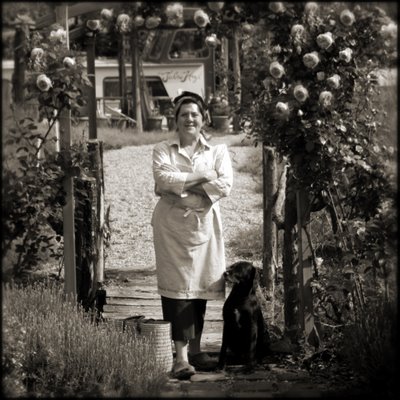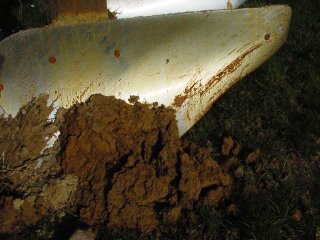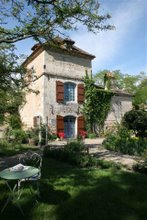September 25, 2006
Friday's children...
Friday- Wine
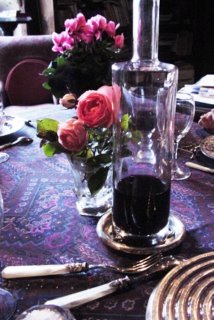
Pig, Duck, Beef, Armagnac… the end of the work 'Week in Gascony' leads to Saturday’s market and later that evening to an FCI/all cooks/all out jammin’ in the French Kitchen. So in anticipation and to give ourselves a respite from the competition style eating we’ve been doing, I plan a day of leisurely swilling and sipping chez two friends of mine, 2 Sisters in Aquitaine. Isabelle and Catherine Orliac's Chateau la Bastide perches above my beloved Garonne River valley near Valance d'Agen. We came looking for good red wine for Saturday’s dinner, what we encountered was a deliciously dark “family secret.”
I first met Isabelle years ago high atop the Garonne vineyards tending delicately made Bordeaux-style wines in the Buzet appellation. Returning to her ancestral home to join her sister, Catherine, they delved deep into the Orliac Family coffers for photographs and artifacts to place in a charmingly personal ‘musee de vin’ on the property. What they discovered set off a historic romp through the annals of Bordeaux wines and resulted in the tell-tale gossip of great-great-great aïeul whose river boat sunk in a Garonne flood in the late 1700’s causing bankruptcy and problems for the talented winemaker. From his soon-to-be last home at Versailles, Louis the Sixteen himself pardoned Jean Orliac in the summer of 1780 allowing him to continue to trade and produce his goodly and medicinally prized wines. It is one of his recipes that inspired the newest Orliac venture, a red-fruit flavored aperitif wine, not-so sweet/not so strong, that is aptly called ‘le Secret de Famille’. Deep ruby, framboise-scented, tinted with tannins of green walnut and other woodsy flavors, it is my own personal newest favorite thing to drink!
Making wines based on the Cote de Bruilhois appellation standard- Merlot, Cabernet Franc, Cabernet Sauvignon and the characteristic Tannat grapes, Catherine and Isabelle shared their other family wine making secrets with us on a pre-lunch visit. Care, attention, passion and pride marry the exceptional terroir of their 24 acre Roman site at Clermont-Soubiran. A love for the land that is bio-diverse and yields a forager’s delight of wild leeks and tulips, flowers and truffle oaks as well as carefully managed vines underscores a savvy and talented vintner’s nose. Dropping in during the middle of their working day, we are greeted by this fairy-tale pair of two sisters—one blonde and one dark, who conjure up magic on their limestone bluff somewhere in Aquitaine.
The FCI-Four departed with cases of a robust 2000, a softer 2002, and a 3-liter bag-in-a-box of the Family Secret. Saturday night’s dinner will be well lubricated and full of FCI gossip!
Stayed tuned for Saturday's feast as four FCI alumni prove that their can't be too many cooks in the French Kitchen.
September 18, 2006
Thursday- Armagnac
This is terroir on a plate. The deep golden ochre of a small patch of land down the hill from a stone building the same color called 'le Rey' is the quintessential definition of terroir. This is what makes armagnac--Armagnac. And this is what makes Guy Arrouy's spectacular armagnac a magical mouthful of honey-colored scents and flavors- the taste of Gascony.
On Day Four of the French Culinary Institute's "Week in Gascony", we drive the slow hills south into the Gers and into the heart of Armagnac production near Eauze. Here the Teneraze and the Bas-Armagnac regions nestle side by side producing both highly perfumed and full flavored eau-de-vies. Guy's land straddles the geological divide and so his output of both exceptional Cotes de Gascogne white wines and a bold and memorable brandy profit from this marriage. It's in the land, boys and girls.
Our 'tour' is in response to my love of this proud winemaker. Guy Arrouy knows I dote on his clean palate and fresh-mouthed wines. His Cote de Gascogne starts with a complex citrusy juice that he draws off the outside vats for us to taste. Sauvignon Blanc, picked and pressed yesterday, is sweet, fresh and hold the promise of a complex little wine. Next, we enter the stock room to taste last year's finished product- a Sauviginon/Colombard blend. But Guy's own pride is a 100% Gros Manseng wine that recalls the late harvest sweet wines of the Jurancon- this is a dry-finished Gascon cousin. With more patience than most American's allow, and only after we have sipped and swirled and swallowed approving the post-breakfast libation, do I dare reveal my dark ulterior motive. Dark as aged brandy, dark as a dimly lit cave, dark and smooth and soft as only a 36 year old armagnac can be.
By definition, brandy produced within the terroir-defined appellation is only called armagnac after ageing three years in oak barrels. When Guy invites us (ok, I begged) to enter the quiet unpretentious chai tucked behind a dozen large cement vats I began to whisper. This is hallowed ground; underscoring the resting spirits there is a zen-like attention to this private reserve. Don't show up and expect to buy any of this! Guy Arrouy only bottles on demand and the large 400 liter casks of resting 1970 and 1972 vintages continue to evolve in rustic tranquility.
With a long clear tube he siphons off generous tastes of his prized vintages. 1970."This is what they sell at Maxim's in Paris." 1982. "Someone in Washington imported this for a diplomat." 1990. "This is the last of what I make. The youngest but not too young." It is as delicious and seductive as only a 16 year-old farm girl can be. With a little bit of cajoling and a lot of gratitude, Guy finds an empty unmarked bottle and fills it by the siphoning tube. It is the color of deep caramel; the color of a slow-burning flame; the color of over 5000 sunsets that have warmed these stone walls cradling it's evolution. It smells of pruneaux- cooked plums and pear. It tastes of cocoa and vanilla and bay. It is smooth in the mouth leaving a lovely long souvenir in the mouth. It is Gascony in a bottle. This is a cook's brandy.
Thursday lunch at Chez Simone in Montreal-du-Gers finished with armagnac. Dinner back at the French Kitchen that night was splashed with armagnac- in sauces and used for deglazing pans. But the moment of glory came when we could sit around the vast round cask-bottom table sated from another day of discovery and good food. Passing the bottle of Guy Arrouy's 'Domaine de Rey' from hand to hand was the finishing taste of just another day in a Week in Gascony.
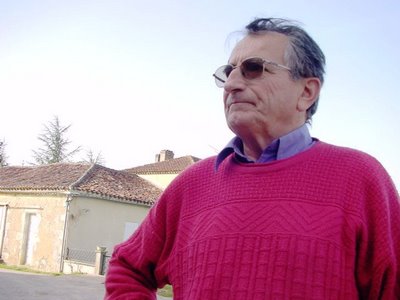
Thursday's Child. Guy Arrouy- distiller and wine maker
Domaine de Rey, Gondrin, Southwest France
September 15, 2006
Wednesday- BEEF plus

Ferme Bellevue
Sabadini Family
47310 Ste.Colombe-en Bruilhois
Wednesday Morning
The weekly Marché at Agen’s Place du Pin (tucked behind the MacDo’s now) waits for no sleepy heads, and after last night’s Duck Fest, the troopeaux are a little slow to move. Promise of a café au lait at the village bar rouses the FCI Four and we are out the door and shopping! Crayon colored umbrellas make neat rows across the parking area and under the covered structure.
Look at what we find and buy:
raw beets with their greens
coco beans in their pods
fresh shallots, onions and garlic tied in ribboned bouquets
mild red, yellow and orange peppers
savory/sweet Muscat grapes
extra virgin honey in its waxy comb
late harvest strawberries- Mara des Bois
home-made vanilla and coffee yoghurts
a sampling of excellent goat cheeses
Our baskets strain with the kilo weights and heavy plastic bags cut into fingers but where’s the beef?
We abandoned the vegetable and fruit stalls and artisan producers for a cross-town jaunt to the Marché couvert or covered hall just off the main drag in Agen. The Pineau Butcher brothers greet us in tidy, green pinstriped shirts and those sexy one-shouldered aprons. In this glass-front refrigerated case hang half-carcasses of veal, beef and lamb. I consider veal tendrons or veal bacon (les parisiennes we call them) to cook with onions and those colorful peppers. Maybe some saucisse d’Agenaise- their special 80% beef and 20% pork sausages to grill rosy until medium rare. Turning to my chicks, I notice everyone is at the other end of the counter.
In that glass-front refrigerated case hang half-carcasses of another four-legged animal. Big. Large muscled. Dark meated. Lean. Erik was the instigator. “Can we buy chevaline?”
Gulp. If you’re thinking Cold War and secret British missiles, go to the back of the butchery class. Think Chivalry, Chevalier and finally Cheval itself. Horse. Never before has a group of foodies, let alone a dedicated, educated group of FCI alumni requested horseflesh. Pourquoi pas?
Horsemeat. Steeped in culinary lore and mythology (a quick look at http://en.wikipedia.org/wiki/Chevaline dispels the notion that only the French eat horse!) horse meat is, in fact, high in protein and iron, low in fat and, in France, just as expensive as prime beef. No one in France eats horse because it is a cheap substitute. Instead it is a deliberate decision based on taste or health issues. Chevaline has long been fed to invalids to speed recovery, either raw as in tartare or cooked in a soup to enrich the broth. But here in Gascony, I always just hear about how good it tastes. By law, a French butcher must separately seperately from beef and chevaline shops were often topped with a statue or picture of the horse's head so as not to be led astray.
Ok, before I get too embroiled in a potentially sensitive issue, let me say that we purchased a sort of skirt steak that begged to be grilled for the pure education of it all. I, who have eaten snake, scarab bugs, grasshoppers, ants and caviar, was going to balk at a little horse steak? No way!
Salted, peppered and thrown over hot coals, Gary grilled and I served everyone a modest 2-inch slice. it got quiet before the usual yummy noises escalated to a happy hum. There was also the braised veal tendrons with meltingly sweet onions and red peppers; a grated raw beet salad made with walnuts, garlic and parsley; Magic coco beans cooked with the beet greens and lardons; Muscat grapes with goat's cheese and honey; a very American strawberry shortcake.
The cheval would just be an experiment, a gustatory amusement, a fleeting taste of the wicked and wild. WRONG. It was delicious. Utterly, meltingly delicious. A taste was not enough. everyone wished for more. Not a morsel left. A smattering of vinaigrette-soaked shallots married with the juices were mopped up with slices of good bread. Thank God for Erik’s CoCo beans that melted in our mouths in garlicky creaminess fullness and sated the tongue as well as the belly. And although Wednesday was for BEEF, it became memorable in our "Week in Gascony" for a little bit of Mr. Ed.
Earlier in the day, our afternoon visit to the Sabadini farm at the corner (my neighborhood “grocery store”) yielded a basket of eggs for a crème anglaise that never materialized (too much food!) and sweet plums destined for confiture des prunes. The working Blondes of Aquitaine (http://www.blondecattle.org/ for more info in English) were gathered around a muscular bull like so many filles in a harem pasture; a few long-legged calves tottered on new pins; the handsome young son of prize-winning Naomi, Apollon, eyed his future happiness through the barn pen. Chickens strutted, geese and ducks danced around the willow tree and the daily life of a contemporary French family farm lay exposed before us as simply as a board game.
Roll a pair of hens and move two steps forward, gather eggs; score a seven, miss a turn and clean the pig pens; a winning roll and a new calf is born with no help; score double noughts and it’s back to cleaning- the chicken coop this time, the rabbit pens next; wait a turn and harvest the three rows of grapes for daily wine; fix the Massey-Ferguson tractor and only then, when the game’s day is over, slide out of your boots, into your slippers and sit at the kitchen table for a meal of your own making. Like most farmers, the Sabadini’s eat the small bits- pork, chicken, rabbit, duck, saving the tender tasty Beef as their cash crop. The work is never ever done in this daily game of Family Farm, but we all win. Good food created by caring people in the Field to Plate, Farm to Table, Full-Circle Life of my Gascon neighbors, the people who turn dirt into food.
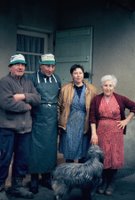
Thank YOU!
September 13, 2006
Tuesday- DUCK
So when the FCI Four announced their intention to consume as much foie gras as possible in this “Week in Gascony”, they didn’t realize how easy it would be in Southwest France to have duck, duck, or goose at every meal. Best of all here, in the heart of Gascony, small artisan poultry farms pepper the patchwork landscape from the Garonne River to the Pyrenees; to steep oneself in the foie gras culture we need only go down road and over the river to Vianne and Patricia Lamarouche’s farm, Puymartin.
We arrived at Puymartin just after the plucking and clean-up of a dozen fat tête rouge or Muscovy ducks. Prized for their flavorful fatted liver and beef-like meat, one duck would provide us with a menu of different recipes.
A déclinaison of DUCK:
grilled magret stuffed with foie gras
a wine-rich civet de canard
cœur de canard en brochette
foie gras en terrine
grattons
frittons
duck fat
grilled demoiselles or duck ribs
In her white tiled workshop, Patricia wields a sharp narrow knife like an extra digit and shows how the gutted carcass is divested of its manteau or cloak. The meaty breasts with legs and wings still attached are carved expertly off the rib cage in one piece. Then with surgical precision, she separates the back from front, trims the duck steaks (magrets), arranges the cuisses or legs, dices the fat and skin for rendering and presents us with a completed butchered duck in less time than it took me to write this paragraph.
Next, we choose from a tray of wrapped livers a small fresh foie gras to slip between the skin and the meat of the breasts before grilling and a jar of foie gras entire to serve on thick slabs of toasted bread. Rillettes, terrines, dried sausage, even duck chorizo are seasoned by Patricia’s expert hand. Her unerring palate is the reason there is always a line at the Lavardac market under her green umbrella. By 11:30 on a brisk market morning, the rabbits, ducks, and chickens that fill her refrigerated market case have all jumped into waiting baskets to join the farm fresh produce and fruit that completes a Gascon menu. No "Week in Gascony" is complete without this Tuesday’s child so full of grace. Merci, Patricia!
Guillaume DILHAN et Patricia LAMAROUCHE.
September 12, 2006
A Week in Gascony: Monday- PIG
I must have been too old to wear them or too young to remember; I’m not sure I even owned any but the image sprang to mind this week as Eric, Claire, Gary and David (all alumni’s of the French Culinary Institute) joined Vetou, Dupont and me for a “Week in Gascony—French Kitchen Adventures.”
During the week we shared a laundry basket of gastronomic colors. If as a group we wore our colors with pride, there is also no shame in sharing what we ate and what we cooked. This is Gascony—the great Southwest France. Here, business, life and love revolve around the table. And especially at the floating table of Camont. Join us for a week of good food and friendly neighbors in my Long Village- a floating table in France.
Monday - PIG
Charcuterie
This is what we bought, cooked and ate:
Boudin noir
Saucisson
Saucisse seche
Grattons
Paté a la tete
Pied de porc
Crépinette
A van load of pig parts. An appetite whetted by the salty parfum of sausage and hanging hams. And a hunger to follow the field to table trail. Sunflower fields, their heavy-seeded heads hanging in anticipation of the harvesters, line the narrow French roads. The plate-sized heads are fat with seeds pressed for oil or used for animal feed. Here at Baradieu, near Mezin in the Lot-et-Garonne, one family has adapted a new version of the family farm into a better working model. Come join us for a tour of what the 4th Little Pig would have build against the big bad economic Wolf at the Door.
Along with corn, barley, wheat, and oats that they grow, the sunflowers feed an artisan level pork production at the Chapolard Family farm. Not just another French Impressionist landscape, the bright sunny faces have now become two-faced. First the sunflower seed pulp milled with the other grains to feed growing piglets then, in an economic tour de force, the oil pressed from the tournesol fields fuels Jacques’ Peugeot 505.
On this family farm, every few weeks, 5-6 sows throw a litter of 12-15 piglets that Bruno will care for and feed, then together with his brothers- Jacques, Dominique and Marc will bring to slaughter. Each Monday morning the brothers are joined by their wives and a few helpers to first butcher and then transform the succulent meat into delicious lardons, ventrêche, boudin, saucissons, saucisses, jambons, paupiettes, pates, terrines…
Tuesdays and Saturdays at Casteljaloux, Wednesdays at Lavardac and Saturday at Nerac a line snakes down the crowded market alleys as loyal customers line up to buy the high-quality selections of ‘L’Art du Cochon’.
“We are selling more than pork”, Dominique confides to us as we stand in the narrow white tiled laboratoire in our plastic booties, “we are selling confidence.”
“We notice our customers are younger, with young families, and that they rely on us for help: how long to cook a pork shoulder roast; how much Saucisse de Toulouse to buy; how best to store the smoked bacon; when to eat rillettes…”
“We sell a relationship, not just meat.”
Tomorrow-
September 02, 2006
T is Terre, Terroir, je suis une Terroirista.
dirt
soil
geology
rain
wind
sun
heat
cold
work
history
love
The sum of these ingredients is a recipe for terroir.
This week I begin a week of being a terroirista as I welcome a group of French Culinary Institute Alumni to my French Kitchen in Gascony. Gascon this and Gascon that, the Cooking of Southwest France, local, neighbors, corner farm, blah, blah, blah. They'll be sick of hearing me spout off about how good, how delicious, how fresh, how does this even work still...
Pigs, Ducks, Cows, Fowl, Wine, Fruit, Armagnac... It's a compressed week of 20 years of living here in France's hidden garden slapped on the my floating table every night. They'll get dirty, they'll get tired, they'll get drunk- then cook. Jambon, pied de porc, magret, demoiselles, tete de veau, boeuf a la mode, pintade a l'armagnac, poule au pot, pruneaux au vin, peche de vigne, chasselas...
Stay tuned and be prepared to be hungry. This French Mother Earth has her apron on!
